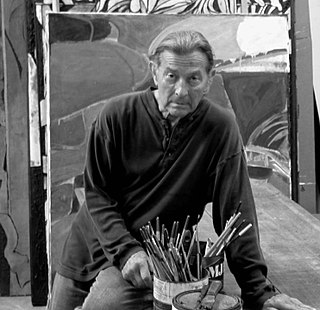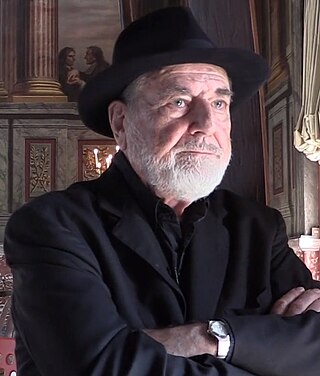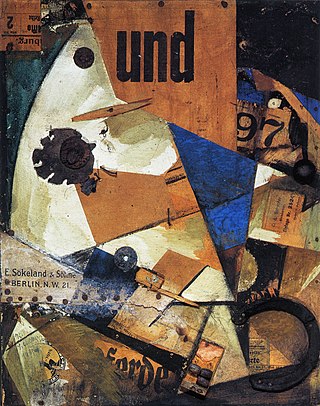
Milton Ernest "Robert" Rauschenberg was an American painter and graphic artist whose early works anticipated the Pop art movement. Rauschenberg is well known for his Combines (1954–1964), a group of artworks which incorporated everyday objects as art materials and which blurred the distinctions between painting and sculpture. Rauschenberg was primarily a painter and a sculptor, but he also worked with photography, printmaking, papermaking and performance.
Bruce Conner was an American artist who worked with assemblage, film, drawing, sculpture, painting, collage, and photography.
Paul Jenkins was an American abstract expressionist painter.

Alex Katz is an American figurative artist known for his paintings, sculptures, and prints. Since 1951, Katz's work has been the subject of more than 200 solo exhibitions and nearly 500 group exhibitions throughout the United States and internationally. He is well known for his large paintings, whose bold simplicity and heightened colors are considered as precursors to Pop Art.

Mark Bradford is an American visual artist. Bradford was born, lives, and works in Los Angeles and studied at the California Institute of the Arts. Recognized for his collaged painting works, which have been shown internationally, his practice also encompasses video, print, and installation. Bradford was the U.S. representative for the 2017 Venice Biennale. He was included in Time Magazine’s list of the 100 Most Influential People in 2021.
David Ratcliff is a painter based in Los Angeles. His work involves spray painting on collages using appropriated images.
Mary Frank is a British and American visual artist who works as a sculptor, painter, printmaker, draftswoman, and illustrator.

Beatriz Milhazes is a Brazilian artist. She is known for her work juxtaposing Brazilian cultural imagery and references to western Modernist painting. Milhazes is a Brazilian-born collage artist and painter known for her large-scale works and vibrant colors. She has been called "Brazil's most successful contemporary painter."
Irwin Kremen was an American artist who began making art while Director of the Duke University Graduate Program in Clinical Psychology, when he was 41, after earning a PhD six years earlier in clinical psychology at Harvard University.

James Jarvaise was an American painter based in Southern California.

Michelangelo Pistoletto is an Italian painter, action and object artist, and art theorist. Pistoletto is acknowledged as one of the main representatives of the Italian Arte Povera. His work mainly deals with the subject matter of reflection and the unification of art and everyday life in terms of a Gesamtkunstwerk.

Sergei Sviatchenko is a Danish-Ukrainian architect, artist, photographer and curator. He is a representative of the Ukrainian New Wave, that arose in Ukraine up through the 1980s. Initiator and creative director of the Less Festival of Collage, Viborg and Just A Few Works. He has lived in Denmark since the 1990s. Sviatchenko graduated from the Kharkov National University of Construction and Architecture in 1975, and in 1986 he obtained a Ph.D. at the National Academy of Visual Arts and Architecture. Sviatchenko is the son of architect Evgenij Sviatchenko (1924–2004), who was a professor of architecture and a member of the National Ukrainian Academy of Fine Arts and Architecture, and engineer Ninel Sviatchenko (1926–2000). In 1975 Sergei Sviatchenko completed his architectural studies at the Kharkov National University of Construction and Architecture. Sergei Sviatchenko is especially oriented towards architecture's modern expressions, including Constructivism and the contemporary European Bauhaus movement. From his teacher, Professor Viktor Antonov, Sviatchenko was introduced to the film director Andrei Tarkovsky, and particularly his film Mirror from 1975 has left a thematic footprint in Sviatchenko's more recent collage art. After having worked as an architect for a number of architectural firms in Kharkov until 1983, Sviatchenko moved to Kyiv, where he graduated the master's program at the Kyiv National University of Construction and Architecture, having completed his Ph.D. dissertation "Means to Visual Information in Architecture".
George Marshall Cohen was an American painter and art professor. He was a member of the Chicago-based Monster Roster group of artists and taught art at Northwestern University.

Collage is a technique of art creation, primarily used in the visual arts, but in music too, by which art results from an assemblage of different forms, thus creating a new whole.
Keith George Sutton was a British artist and critic.
Marie Elisabeth Chichester Rideal (born 1954 in Aylesbury, Buckinghamshire) is a British artist, art historian, educator and author. She is a Professor in Fine Art in the Painting Department at the Slade School of Fine Art, University College London and was a lecturer and educational resource writer at the National Portrait Gallery, London. She is known for her early artwork, fine art photography made using a photo-booth. Rideal currently lives and works in London, England.
Elaine Lustig Cohen was an American graphic designer, artist and archivist. She is best known for her work as a graphic designer during the 1950s and 60s, having created over 150 designs for book covers and museum catalogs. Her work has played a significant role in the evolution of American modernist graphic design, integrating European avant-garde with experimentation to create a distinct visual vocabulary. Cohen later continued her career as a fine artist working in a variety of media. In 2011, she was named an AIGA Medalist for her achievements in graphic design.

Gallery Arcturus is an art gallery and museum in downtown Toronto, Ontario, Canada. It is located in the Garden District neighbourhood on Gerrard Street East near Toronto Metropolitan University and the Church and Wellesley area. The gallery is a member of Galeries Ontario / Ontario Galleries and the Ontario Museum Association.
Alfred Cohen (1920-2001) was an American artist whose art was firmly rooted in the European tradition; he was inspired in particular by the commedia dell'arte; and by the colour and handling of the Post-Impressionists and Expressionists.
Maeve Woods is an Australian artist based in Tasmania.








